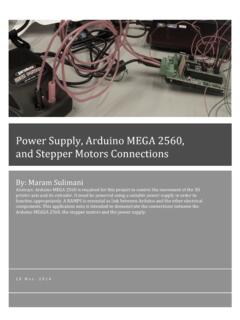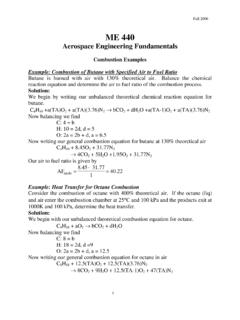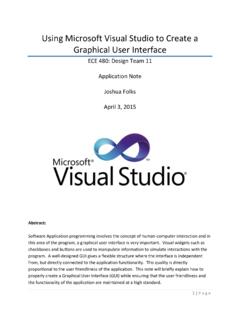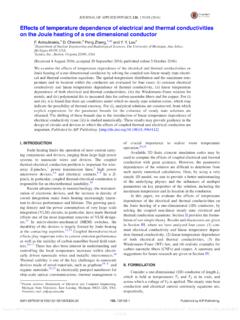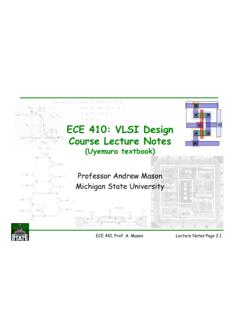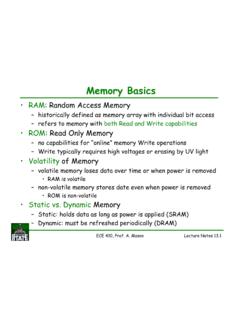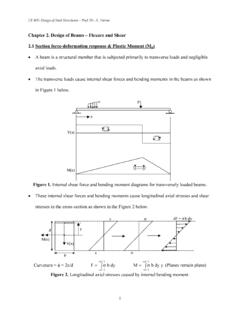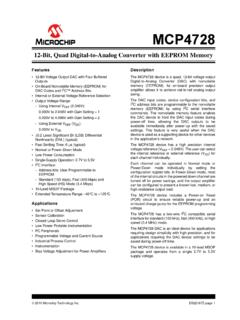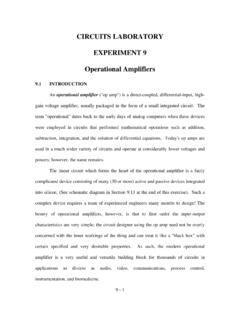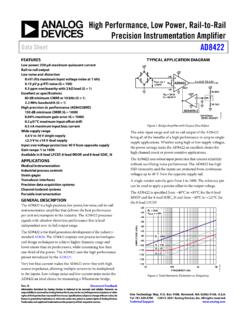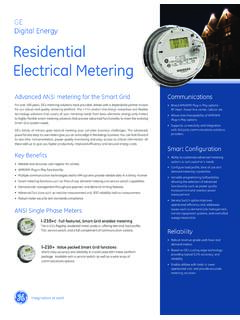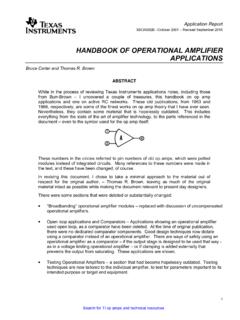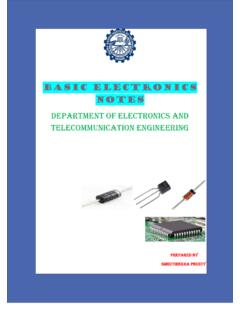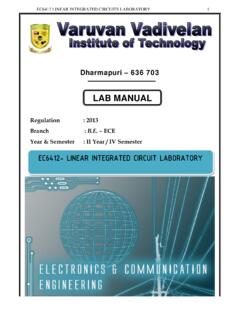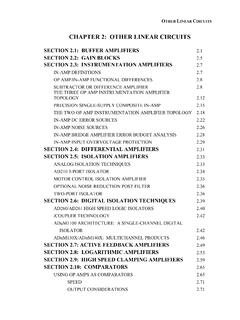Transcription of Medical Instrumentation - Michigan State University
1 Ch1 Basics. p. 1 ECE 445: Biomedical Instrumentation Design of instrument must match Measurement needs (environmental conditions, safety, reliability, etc) Instrument performance (speed, power, resolution, range, etc) A Medical device is any item promoted for a Medical purpose that does not rely on chemical action to achieve its intended effect [ Medical Device Amendments (Public law 94-295)] , any electrical or mechanical device for Medical applications this class will focus on electrical (including electromechanical and electrochemical) Difference from any conventional instrument source of signals is living tissue energy is applied to the living tissue Impact on biomedical Instrumentation (BI) design requirements?
2 Reliability and Safety Medical Instrumentation Ch1 Basics. p. 2 ECE 445: Biomedical Instrumentation Generalized Medical Instrumentation System sensor actuator electronic Instrumentation signal conditioning basic advanced signal processing output display storage transmission feedback measurand Measurand: Physical quantity, property or condition that the system measures Types of biomedical measurands Internal Blood pressure Body surface ECG or EEG potentials Peripheral Infrared radiation Offline Extract tissue sample, blood analysis, or biopsy Typical biomedical measurand quantities Biopotential, pressure, flow, dimensions (imaging), displacement (velocity, acceleration and force), impedance, temperature and chemical concentration Ch1 Basics.
3 P. 3 ECE 445: Biomedical Instrumentation Medical and Physiological Parameters Parameter Range Frequency Sensor Blood flow 1-300 ml/s dc 20 Hz Flowmeter (ultrasonic) Arterial blood pressure 25-400mm Hg dc 50 Hz Cuff, strain-gage ECG 4 mV 250 Hz Skin electrodes EEG 5 300 microV dc 150 Hz Scalp electrodes EMG 5 mV dc 10,000 Hz Needle electrodes Respiratory rate 2 50 breaths/min 10 Hz Strain-gage, nasal thermistor Ch1 Basics. p. 4 ECE 445: Biomedical Instrumentation Sensor sensor actuator electronic Instrumentation signal conditioning basic advanced signal processing output display storage transmission feedback measurand A sensor converts physical measurand to an electrical output Sensor requirements Selective should respond to a specific form of energy in the measurand Minimally invasive (invasive = requiring entry into a part of the body) sensor should not affect the response of the living tissue Most common types of sensors in biomedical systems displacement pressure Ch1 Basics.
4 P. 5 ECE 445: Biomedical Instrumentation Signal Conditioning sensor actuator electronic Instrumentation signal conditioning basic advanced signal processing output display storage transmission feedback measurand Signal Conditioning: Amplification and filtering of the signal acquired from the sensor to make it suitable for display General categories Analog, digital or mixed-signal signal conditioning Time/frequency/spatial domain processing ( , filtering) Calibration (adjustment of output to match parameter measured) Compensation (remove of undesirable secondary sensitivities) Units of Measurement Fundamental SI units SI = Systemes Internationales d Unites Derived SI units Ch1 Basics.
5 P. 6 ECE 445: Biomedical Instrumentation source: A. Morris, Principles of Instrumentation and Measurement, 3rd Ed., Butterworth-Heinemann, 2001. Units of Measurement Unit Definitions Ch1 Basics. p. 7 ECE 445: Biomedical Instrumentation source: A. Morris, Principles of Instrumentation and Measurement, 3rd Ed., Butterworth-Heinemann, 2001. Ch1 Basics. p. 8 ECE 445: Biomedical Instrumentation BI Operational Modes Direct vs. Indirect Direct mode: measure desired measurand directly if the sensor is invasive, direct contact with the measurand is possible but expensive, risky and least acceptable Indirect mode: measure a quantity that is accessible and related to the desired measurand assumption.
6 The relationship between the measurands is already known often chosen when the measurand requires invasive procedures to measure directly Example indirect mode Cardiac output (volume of blood pumped per minute by the heart) can be determined from measurement of respiration, blood gas concentration & dye dilution Organ morphology can be determined from x-ray shadows BI = biomedical Instrumentation Ch1 Basics. p. 9 ECE 445: Biomedical Instrumentation BI Operational Modes Sampling vs. Continuous mode Sampling: for slow varying measurands that are sensed infrequently like body temperature & ion concentrations Continuous: for critical measurements requiring constant monitoring like electro-cardiogram and respiratory gas flow Generating vs.
7 Modulating Generating: also known as self-powered mode derive their operational energy from the measurand itself Example: piezoelectric sensors, solar cells Modulating: measurand modulates the electrical signal which is supplied externally modulation affects output of the sensor Example: photoconductive or piezoresistive sensor Ch1 Basics. p. 10 ECE 445: Biomedical Instrumentation BI Operational Modes Analog vs. digital modes most sensors are inherently analog (some optical sensors are exceptions) require analog-to-digital converters before any DSP techniques could be applied for filtering Real-time vs. Delayed-time mode Real-time Example: ECG signals need to measured in real-time to determine an impending cardiac arrest Delayed-time Example: cell cultures which requires several days before any output is acquired Ch1 Basics.
8 P. 11 ECE 445: Biomedical Instrumentation Measurement Constraints The signal to be measured imposes constraints on how it should be acquired and processed Signal/frequency ranges Most Medical measurands parameters are typically much lower than conventional sensing parameters (microvolts, mm Hg, low frequency) Interference and cross-talk Noise from environment, instruments, etc. Other measurands affect measurement (and can t be isolated) , Cannot measure EEG without interference from EMG Require filtering and/or compensation Placement of sensor(s) in/on/near the body plays a key role in any bio- Instrumentation design Ch1 Basics.
9 P. 12 ECE 445: Biomedical Instrumentation Measurement Constraints Measurement variability is inherent at molecular, organ and body level Primary cause interaction between different physiological systems existence of numerous feedback loops whose properties are poorly understood Therefore evaluation of biomedical devices rely on probabilistic/statistical methods (biostatistics) SAFETY Due to interaction of sensor with living tissue, safety is a primary consideration in all phases of the design & testing process the damage caused could be irreversible In many cases, safe levels of energy is difficult to establish Safety of Medical personnel also must be considered Operator constraints Reliable, easy to operate, rugged and durable Ch1 Basics.
10 P. 13 ECE 445: Biomedical Instrumentation Classification of biomedical instruments Quantity being sensed pressure, flow or temperature makes comparison of different technologies easy Principle of transduction resistive, inductive, capacitive, ultrasonic or electrochemical makes development of new applications easy Organ systems cardiovascular, pulmonary, nervous, endocrine isolates all important measurements for specialists who need to know about a specific area Clinical specialties pediatrics, obstetrics, cardiology or radiology easy for Medical personnel interested in specialized equipment. Ch1 Basics.
